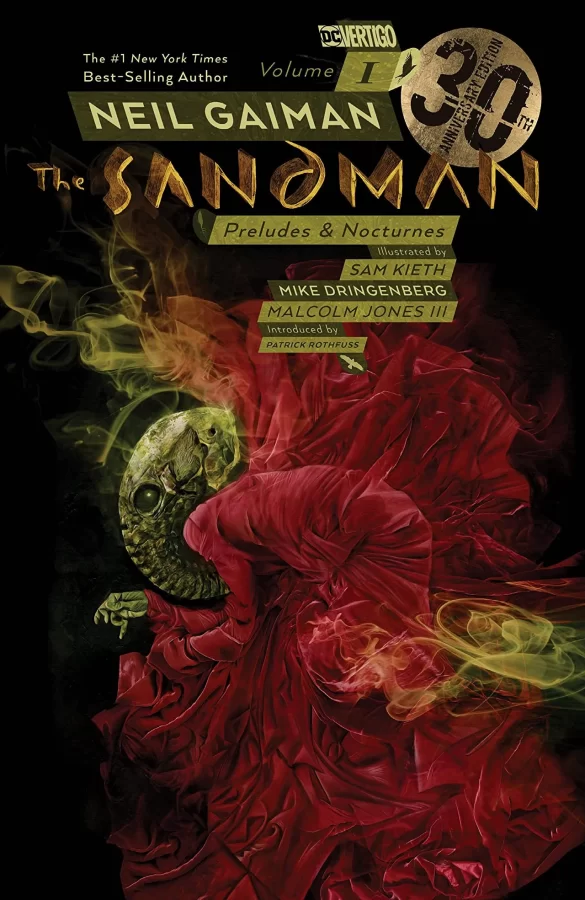Exploring the success of ‘The Sandman’
Neil Gaiman’s experiment in genre-melding became a cult classic in comics
Gaiman’s “Sandman” series captivates audiences.
March 24, 2022
Neil Gaiman — an author known for “Coraline” (2002), “The Graveyard Book” (2008) and “American Gods” (2001) — has been a sensation in the comic book industry with his award-winning series “The Sandman” (1989), first published over 30 years ago. However, “The Sandman” is now more mainstream than ever because it is being released as a Netflix show this year.
DC Comics originally confronted Gaiman after publishing his short comic series “Black Orchid” (1987) to reinvent Gardner Fox’s original “Sandman” (1939) series. Fox’s “Sandman” included a typical superhero origin story in which the main character, Wesley Dodds, used a gas mask with scientifically-advanced elements to pursue enemies in his nightmares.
Gaiman altered the stereotypical hero story by flipping the trope of the superhero on its head, reinventing the original story and characters. In his version, the protagonist of the comic — called Morpheus, Sandman and Dream, among other names — is the personification of dreams coupled with darkness that creates layers of mysteries and secrets waiting to be unfolded. He acts as a common thread that connects to the storyline, winding the seemingly-disjointed story around his presence.
Morpheus is an enthralling protagonist because readers are not given his origin story. As the comic progresses, Morpheus’ traits and past are introduced through secondary characters’ experiences rather than his own. Due to this stylistic decision, his identity remains largely concealed to the reader. Gaiman’s character choices create depth within the story and allow the vast abyss of possibilities to remain open for Morpheus’ character arc, simultaneously formulating an ominous air around the character.
Hot off the press, “The Sandman” became a resounding success that paved the way for a new form of visual storytelling despite the altered relations between Gaiman and his illustrators throughout the first several issues.
“The Sandman” story itself was an experiment in narration, as Gaiman used the elements of comics to his advantage. Pages and strips were organized to draw the reader’s eye to specific aspects of the story that added profundity to the story and characters. For instance, a continuous image would travel across the bottom of two adjacent pages, adding a linear dimension to the storyline and implying an ongoing sense of motion in the tale’s background events.
What makes “The Sandman” so successful in the art of storytelling is its brilliant weaving of vignettes which function within reinventions of comic genres. Each issue may feel like a disconnected and inconclusive tale, but the conclusion of a volume of issues ties each story together. In doing so, aspects of Morpheus’ character are revealed, and the greater motive of the story comes to light.
Gaiman’s ability to execute this method of storytelling in collaboration with his illustrators improves over the course of the comic, constantly refining and developing the narrative. Not to mention the fact that the addition of interwoven genres among these vignettes carries the reader through the explorative journey that Gaiman himself is experiencing as he creates.
The writing and presentation of “The Sandman” propelled comics beyond the status quo — literary storytelling became a plausible goal for authors who were only ever regarded as comic writers rather than anything more. Gaiman’s work inspired a new generation of literary fiction in comics like “The Walking Dead” (2003). Additionally, his choice to intertwine horror, dark fantasy and thriller excursions placed Gaiman’s tales at the helm of a brand new ecosystem of literature in both comics and graphic novels.
It is no wonder that “The Sandman” is being adapted into a Netflix series with high hopes for success. Netflix is the perfect platform to flesh out stories told in the fashion that Gaiman has adopted — especially those functioning within the comic landscape. Each episode can be dedicated to an issue with an emphasis on subtle details that may have been overlooked in the comics, allowing for an enhanced understanding of the tale. Gaiman’s fantastical and horror elements can really shine in the silver screen format — the opportunities for added mysticism in this medium are abundant.
Alas, “The Sandman” concluded years ago, despite the wishes of many fans who would have liked to follow Morpheus for eternity. However, it was essential that the comic end with the bang with which it commenced; otherwise, its integrity may not have prevailed. Netflix has the opportunity to rejuvenate the comic in the social strata — I and others simply hope that justice is delivered to our beloved Morpheus.















